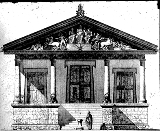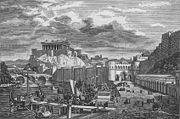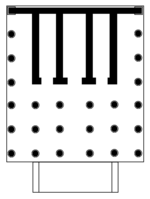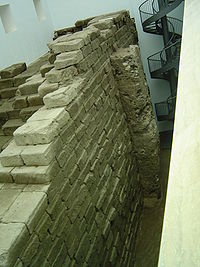
Temple of Jupiter
Encyclopedia
The Temple of Jupiter Optimus Maximus, also known as the Temple of Jupiter Capitolinus (Latin: Aedes Iovis Optimi Maximi Capitolini, , English: "Temple of Jupiter Best and Greatest on the Capitoline") was the most important temple in Ancient Rome
, located on the Capitoline Hill
.
 Much of what is known of the first Temple of Jupiter is from later Roman tradition. Lucius Tarquinius Priscus vowed this temple while battling with the Sabines, and according to Dionysius of Halicarnassus
Much of what is known of the first Temple of Jupiter is from later Roman tradition. Lucius Tarquinius Priscus vowed this temple while battling with the Sabines, and according to Dionysius of Halicarnassus
began the terracing necessary to support the foundations of the temple. Modern coring on the Capitoline has confirmed the extensive work needed just to create a level building site. According to Dionysius of Halicarnassus and Livy
, the foundations and most of the superstructure of the temple were completed by Lucius Tarquinius Superbus
.
Livy also records that before the temple's construction shrines to other gods occupied the site. When the augur
s carried out the rites seeking permission to remove them, only Terminus
and Juventas were believed to have refused.Their shrines were therefore incorporated into the new structure. Because he was the god of boundaries, Terminus's refusal to be moved was interpreted as a favorable omen for the future of the Roman state. A second portent was the appearance of the head of a man to workmen digging the foundations of the temple. This was said by the augurs (including augurs brought especially from Etruria
) to mean that Rome was to be the head of a great empire.
It was said that the Temple of Jupiter was dedicated on September 13 the year of the Roman Republic
, c. 509 BC. It was sacred to the Capitoline Triad
consisting of Jupiter and his companion deities, Juno
and Minerva
.
The man to perform the dedication of the temple was chosen by lot. The duty fell to Marcus Horatius Pulvillus
, one of the consul
s in that year.
The original Temple measured almost 60 x 60 m and was considered the most important religious temple of the whole state of Rome. Each deity of the Triad had a separate cella
, with Juno Regina on the left, Minerva on the right, and Jupiter Optimus Maximus in the middle. The first temple was decorated with many terra cotta
sculptures. The most famous of these was of Jupiter driving a quadriga
, a chariot drawn by four horses, which was on top of the roof as an acroterion
. This sculpture, as well as the cult statue of Jupiter in the main cella, was said to have been the work of Etruscan
artisan Vulca
of Veii
. An image of Summanus
, a thunder god, was among the pedimental statues.
The plan and exact dimensions of the temple have been heavily debated. Five different plans of the temple have been published following recent excavations on the Capitoline Hill that revealed portions of the archaic foundations. According to Dionysius of Halicarnassus, the same plan and foundations were used for later rebuildings of the temple.
The first Temple burned in 83 BC, during the civil wars under the dictatorship of Sulla
. Also lost in this fire were the Sibylline Books
, which were said to have been written by classical sibyls, and stored in the Temple (to be guarded and consulted by the Quindecemviri
(council of fifteen) on matters of state only on emergencies).
 Sulla hoped to live until the temple was rebuilt, but Quintus Lutatius Catulus
Sulla hoped to live until the temple was rebuilt, but Quintus Lutatius Catulus
had the honor of dedicating the new structure in 69 BC. The new temple was built to the same plan on the same foundations, but with more expensive materials for the superstructure. Literary sources indicate that the temple was not entirely completed until the late 60s BC.
Brutus
and the other assassins locked themselves inside it after murdering Caesar
. The new temple of Quintus Lutatius Catulus
was renovated and repaired by Augustus
.
The second building burnt down during the course of fighting on the hill on December 19 in 69 AD, when Vespasian
battled to enter the city as Emperor in the Year of the Four Emperors
. Domitian
narrowly escaped with his life.
in the great fire of AD 80.
immediately began rebuilding the temple, again on the same foundations, but with the most lavish superstructure yet. According to ancient sources, Domitian used at least twelve thousands talents
of gold for the gilding of the bronze roof tiles alone. Elaborate sculpture
adorned the pediment
. A Renaissance
drawing of a damaged relief in the Louvre Museum shows a four-horse chariot (quadriga
) beside a two-horse chariot (biga
) to the right of the latter at the highest point of the pediment, the two statues serving as the central acroterion
, and statues of the god Mars and goddess Venus surmounting the corners of the cornice
, serving as acroteria.
In the center of the pediment the god Jupiter was flanked by Juno and Minerva, seated on thrones. Below was an eagle with wings spread out. A biga driven by the sun god and a biga driven by the moon were depicted either side of the three gods.
The temple completed by Domitian is thought to have lasted more or less intact for over four hundred years, until the fifth century depredations of Stilicho
, Gaiseric, and Narses
.
 Today, portions of the temple foundations can be seen behind the Palazzo dei Conservatori, in an exhibition area built in the Caffarelli Garden, and within the Musei Capitolini.
Today, portions of the temple foundations can be seen behind the Palazzo dei Conservatori, in an exhibition area built in the Caffarelli Garden, and within the Musei Capitolini.
Ancient Rome
Ancient Rome was a thriving civilization that grew on the Italian Peninsula as early as the 8th century BC. Located along the Mediterranean Sea and centered on the city of Rome, it expanded to one of the largest empires in the ancient world....
, located on the Capitoline Hill
Capitoline Hill
The Capitoline Hill , between the Forum and the Campus Martius, is one of the seven hills of Rome. It was the citadel of the earliest Romans. By the 16th century, Capitolinus had become Capitolino in Italian, with the alternative Campidoglio stemming from Capitolium. The English word capitol...
.
First building

Dionysius of Halicarnassus
Dionysius of Halicarnassus was a Greek historian and teacher of rhetoric, who flourished during the reign of Caesar Augustus. His literary style was Attistic — imitating Classical Attic Greek in its prime.-Life:...
began the terracing necessary to support the foundations of the temple. Modern coring on the Capitoline has confirmed the extensive work needed just to create a level building site. According to Dionysius of Halicarnassus and Livy
Livy
Titus Livius — known as Livy in English — was a Roman historian who wrote a monumental history of Rome and the Roman people. Ab Urbe Condita Libri, "Chapters from the Foundation of the City," covering the period from the earliest legends of Rome well before the traditional foundation in 753 BC...
, the foundations and most of the superstructure of the temple were completed by Lucius Tarquinius Superbus
Lucius Tarquinius Superbus
Lucius Tarquinius Superbus was the legendary seventh and final King of Rome, reigning from 535 BC until the popular uprising in 509 BC that led to the establishment of the Roman Republic. He is more commonly known by his cognomen Tarquinius Superbus and was a member of the so-called Etruscan...
.
Livy also records that before the temple's construction shrines to other gods occupied the site. When the augur
Augur
The augur was a priest and official in the classical world, especially ancient Rome and Etruria. His main role was to interpret the will of the gods by studying the flight of birds: whether they are flying in groups/alone, what noises they make as they fly, direction of flight and what kind of...
s carried out the rites seeking permission to remove them, only Terminus
Terminus (mythology)
In Roman religion, Terminus was the god who protected boundary markers; his name was the Latin word for such a marker. Sacrifices were performed to sanctify each boundary stone, and landowners celebrated a festival called the "Terminalia" in Terminus' honor each year on February 23...
and Juventas were believed to have refused.Their shrines were therefore incorporated into the new structure. Because he was the god of boundaries, Terminus's refusal to be moved was interpreted as a favorable omen for the future of the Roman state. A second portent was the appearance of the head of a man to workmen digging the foundations of the temple. This was said by the augurs (including augurs brought especially from Etruria
Etruria
Etruria—usually referred to in Greek and Latin source texts as Tyrrhenia—was a region of Central Italy, an area that covered part of what now are Tuscany, Latium, Emilia-Romagna, and Umbria. A particularly noteworthy work dealing with Etruscan locations is D. H...
) to mean that Rome was to be the head of a great empire.
It was said that the Temple of Jupiter was dedicated on September 13 the year of the Roman Republic
Roman Republic
The Roman Republic was the period of the ancient Roman civilization where the government operated as a republic. It began with the overthrow of the Roman monarchy, traditionally dated around 508 BC, and its replacement by a government headed by two consuls, elected annually by the citizens and...
, c. 509 BC. It was sacred to the Capitoline Triad
Capitoline Triad
In ancient Roman religion, the Capitoline Triad was a group of three supreme deities who were worshipped in an elaborate temple on Rome's Capitoline Hill, the Capitolium. Two distinct Capitoline Triads were worshipped at various times in Rome's history, both originating in ancient traditions...
consisting of Jupiter and his companion deities, Juno
Juno (mythology)
Juno is an ancient Roman goddess, the protector and special counselor of the state. She is a daughter of Saturn and sister of the chief god Jupiter and the mother of Mars and Vulcan. Juno also looked after the women of Rome. Her Greek equivalent is Hera...
and Minerva
Minerva
Minerva was the Roman goddess whom Romans from the 2nd century BC onwards equated with the Greek goddess Athena. She was the virgin goddess of poetry, medicine, wisdom, commerce, weaving, crafts, magic...
.
The man to perform the dedication of the temple was chosen by lot. The duty fell to Marcus Horatius Pulvillus
Marcus Horatius Pulvillus
Marcus Horatius Pulvillus was a figure in Ancient Rome at the time of the overthrow of the Roman monarchy. He was consul in 509 BC and again in 507 BC.-Biography:...
, one of the consul
Consul
Consul was the highest elected office of the Roman Republic and an appointive office under the Empire. The title was also used in other city states and also revived in modern states, notably in the First French Republic...
s in that year.
The original Temple measured almost 60 x 60 m and was considered the most important religious temple of the whole state of Rome. Each deity of the Triad had a separate cella
Cella
A cella or naos , is the inner chamber of a temple in classical architecture, or a shop facing the street in domestic Roman architecture...
, with Juno Regina on the left, Minerva on the right, and Jupiter Optimus Maximus in the middle. The first temple was decorated with many terra cotta
Terra cotta
Terracotta, Terra cotta or Terra-cotta is a clay-based unglazed ceramic, although the term can also be applied to glazed ceramics where the fired body is porous and red in color...
sculptures. The most famous of these was of Jupiter driving a quadriga
Quadriga
A quadriga is a car or chariot drawn by four horses abreast . It was raced in the Ancient Olympic Games and other contests. It is represented in profile as the chariot of gods and heroes on Greek vases and in bas-relief. The quadriga was adopted in ancient Roman chariot racing...
, a chariot drawn by four horses, which was on top of the roof as an acroterion
Acroterion
An acroterion or acroterium is an architectural ornament placed on a flat base called the acroter or plinth, and mounted at the apex of the pediment of a building in the Classical style. It may also be placed at the outer angles of the pediment; such acroteria are referred to as acroteria angularia...
. This sculpture, as well as the cult statue of Jupiter in the main cella, was said to have been the work of Etruscan
Etruscan art
Etruscan art was the form of figurative art produced by the Etruscan civilization in central Italy between the 9th and 2nd centuries BC. Particularly strong in this tradition were figurative sculpture in terracotta and cast bronze, wall-painting and metalworking .-History:The origins of...
artisan Vulca
Vulca
Vulca was an Etruscan artist from the town of Veii. The only Etruscan artist mentioned by ancient writers, he worked for the last of the Roman kings, Tarquinius Superbus. He is responsible for creating a terracotta statue of Jupiter that was inside the Temple of Jupiter Optimus Maximus on the...
of Veii
Veii
Veii was, in ancient times, an important Etrurian city NNW of Rome, Italy; its site lies in Isola Farnese, a village of Municipio XX, an administrative subdivision of the comune of Rome in the Province of Rome...
. An image of Summanus
Summanus
In ancient Roman religion, Summanus was the god of nocturnal thunder, as counterposed to Jupiter, the god of diurnal thunder. His precise nature was unclear even to Ovid....
, a thunder god, was among the pedimental statues.
The plan and exact dimensions of the temple have been heavily debated. Five different plans of the temple have been published following recent excavations on the Capitoline Hill that revealed portions of the archaic foundations. According to Dionysius of Halicarnassus, the same plan and foundations were used for later rebuildings of the temple.
The first Temple burned in 83 BC, during the civil wars under the dictatorship of Sulla
Lucius Cornelius Sulla
Lucius Cornelius Sulla Felix , known commonly as Sulla, was a Roman general and statesman. He had the rare distinction of holding the office of consul twice, as well as that of dictator...
. Also lost in this fire were the Sibylline Books
Sibylline Books
The Sibylline Books or Libri Sibyllini were a collection of oracular utterances, set out in Greek hexameters, purchased from a sibyl by the last king of Rome, Tarquinius Superbus, and consulted at momentous crises through the history of the Republic and the Empire...
, which were said to have been written by classical sibyls, and stored in the Temple (to be guarded and consulted by the Quindecemviri
Quindecemviri sacris faciundis
In ancient Rome, the quindecimviri sacris faciundis were the fifteen members of a college with priestly duties. Most notably they guarded the Sibylline Books, scriptures which they consulted and interpreted at the request of the Senate...
(council of fifteen) on matters of state only on emergencies).
Second building

Quintus Lutatius Catulus
Quintus Lutatius Catulus was consul of the Roman Republic in 102 BC, and the leading public figure of the gens Lutatia of the time. His colleague in the consulship was Gaius Marius, but the two feuded and Catulus sided with Sulla in the civil war of 88–87 BC...
had the honor of dedicating the new structure in 69 BC. The new temple was built to the same plan on the same foundations, but with more expensive materials for the superstructure. Literary sources indicate that the temple was not entirely completed until the late 60s BC.
Brutus
Decimus Junius Brutus
Decimus Junius Brutus may refer to:*Decimus Junius Brutus Scaeva was consul in 325 BC*Decimus Junius Brutus Scaeva was consul in 292 BC; he is best known for introducing gladiatorial games to Rome in 264 BC...
and the other assassins locked themselves inside it after murdering Caesar
Julius Caesar
Gaius Julius Caesar was a Roman general and statesman and a distinguished writer of Latin prose. He played a critical role in the gradual transformation of the Roman Republic into the Roman Empire....
. The new temple of Quintus Lutatius Catulus
Quintus Lutatius Catulus
Quintus Lutatius Catulus was consul of the Roman Republic in 102 BC, and the leading public figure of the gens Lutatia of the time. His colleague in the consulship was Gaius Marius, but the two feuded and Catulus sided with Sulla in the civil war of 88–87 BC...
was renovated and repaired by Augustus
Augustus
Augustus ;23 September 63 BC – 19 August AD 14) is considered the first emperor of the Roman Empire, which he ruled alone from 27 BC until his death in 14 AD.The dates of his rule are contemporary dates; Augustus lived under two calendars, the Roman Republican until 45 BC, and the Julian...
.
The second building burnt down during the course of fighting on the hill on December 19 in 69 AD, when Vespasian
Vespasian
Vespasian , was Roman Emperor from 69 AD to 79 AD. Vespasian was the founder of the Flavian dynasty, which ruled the Empire for a quarter century. Vespasian was descended from a family of equestrians, who rose into the senatorial rank under the Emperors of the Julio-Claudian dynasty...
battled to enter the city as Emperor in the Year of the Four Emperors
Year of the Four Emperors
The Year of the Four Emperors was a year in the history of the Roman Empire, AD 69, in which four emperors ruled in a remarkable succession. These four emperors were Galba, Otho, Vitellius, and Vespasian....
. Domitian
Domitian
Domitian was Roman Emperor from 81 to 96. Domitian was the third and last emperor of the Flavian dynasty.Domitian's youth and early career were largely spent in the shadow of his brother Titus, who gained military renown during the First Jewish-Roman War...
narrowly escaped with his life.
Third building
The new emperor, Vespasian, rapidly rebuilt the temple on the same foundations but with a lavish superstructure. The third temple of Jupiter was dedicated in AD 75. The third temple burned during the reign of TitusTitus
Titus , was Roman Emperor from 79 to 81. A member of the Flavian dynasty, Titus succeeded his father Vespasian upon his death, thus becoming the first Roman Emperor to come to the throne after his own father....
in the great fire of AD 80.
Fourth building
DomitianDomitian
Domitian was Roman Emperor from 81 to 96. Domitian was the third and last emperor of the Flavian dynasty.Domitian's youth and early career were largely spent in the shadow of his brother Titus, who gained military renown during the First Jewish-Roman War...
immediately began rebuilding the temple, again on the same foundations, but with the most lavish superstructure yet. According to ancient sources, Domitian used at least twelve thousands talents
Talent (weight)
The "talent" was one of several ancient units of mass, as well as corresponding units of value equivalent to these masses of a precious metal. It was approximately the mass of water required to fill an amphora. A Greek, or Attic talent, was , a Roman talent was , an Egyptian talent was , and a...
of gold for the gilding of the bronze roof tiles alone. Elaborate sculpture
Sculpture
Sculpture is three-dimensional artwork created by shaping or combining hard materials—typically stone such as marble—or metal, glass, or wood. Softer materials can also be used, such as clay, textiles, plastics, polymers and softer metals...
adorned the pediment
Pediment
A pediment is a classical architectural element consisting of the triangular section found above the horizontal structure , typically supported by columns. The gable end of the pediment is surrounded by the cornice moulding...
. A Renaissance
Renaissance
The Renaissance was a cultural movement that spanned roughly the 14th to the 17th century, beginning in Italy in the Late Middle Ages and later spreading to the rest of Europe. The term is also used more loosely to refer to the historical era, but since the changes of the Renaissance were not...
drawing of a damaged relief in the Louvre Museum shows a four-horse chariot (quadriga
Quadriga
A quadriga is a car or chariot drawn by four horses abreast . It was raced in the Ancient Olympic Games and other contests. It is represented in profile as the chariot of gods and heroes on Greek vases and in bas-relief. The quadriga was adopted in ancient Roman chariot racing...
) beside a two-horse chariot (biga
Biga (chariot)
The biga is the two-horse chariot as used in ancient Rome for sport, transportation, and ceremonies. Other animals may replace horses in art and occasionally for actual ceremonies. The term biga is also used by modern scholars for the similar chariots of other Indo-European cultures, particularly...
) to the right of the latter at the highest point of the pediment, the two statues serving as the central acroterion
Acroterion
An acroterion or acroterium is an architectural ornament placed on a flat base called the acroter or plinth, and mounted at the apex of the pediment of a building in the Classical style. It may also be placed at the outer angles of the pediment; such acroteria are referred to as acroteria angularia...
, and statues of the god Mars and goddess Venus surmounting the corners of the cornice
Cornice
Cornice molding is generally any horizontal decorative molding that crowns any building or furniture element: the cornice over a door or window, for instance, or the cornice around the edge of a pedestal. A simple cornice may be formed just with a crown molding.The function of the projecting...
, serving as acroteria.
In the center of the pediment the god Jupiter was flanked by Juno and Minerva, seated on thrones. Below was an eagle with wings spread out. A biga driven by the sun god and a biga driven by the moon were depicted either side of the three gods.
The temple completed by Domitian is thought to have lasted more or less intact for over four hundred years, until the fifth century depredations of Stilicho
Stilicho
Flavius Stilicho was a high-ranking general , Patrician and Consul of the Western Roman Empire, notably of Vandal birth. Despised by the Roman population for his Germanic ancestry and Arian beliefs, Stilicho was in 408 executed along with his wife and son...
, Gaiseric, and Narses
Narses
Narses was, with Belisarius, one of the great generals in the service of the Byzantine Emperor Justinian I during the "Reconquest" that took place during Justinian's reign....
.
Remains today


